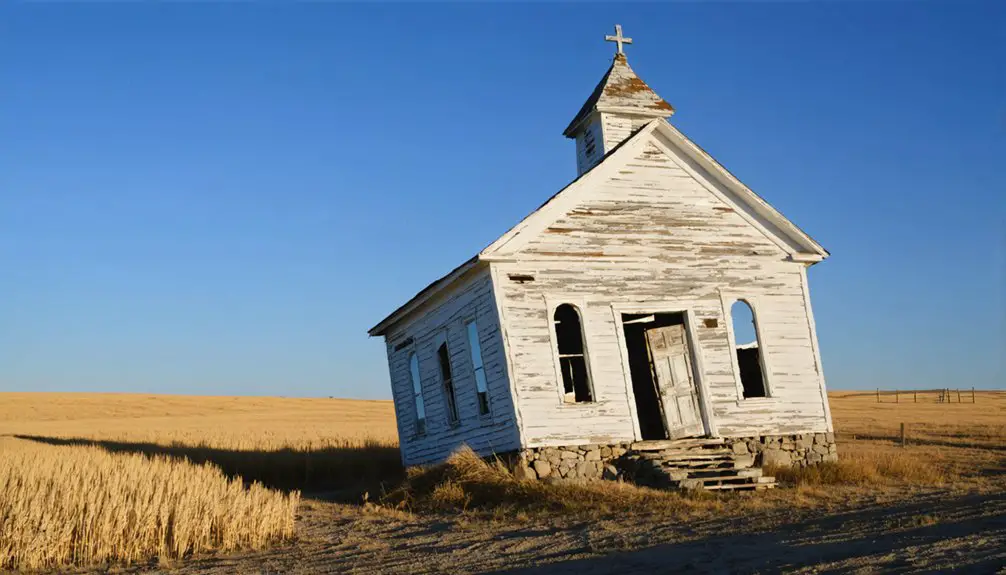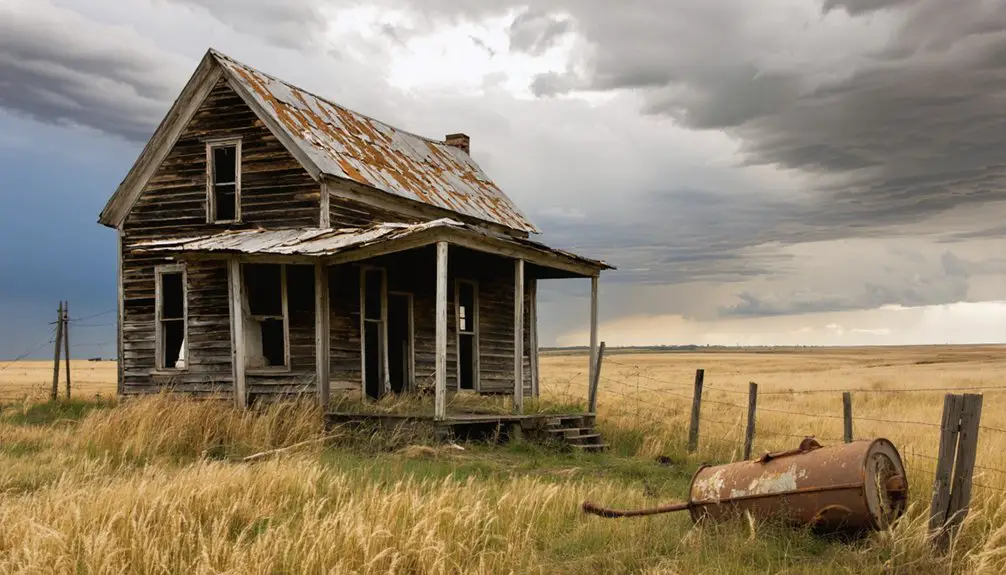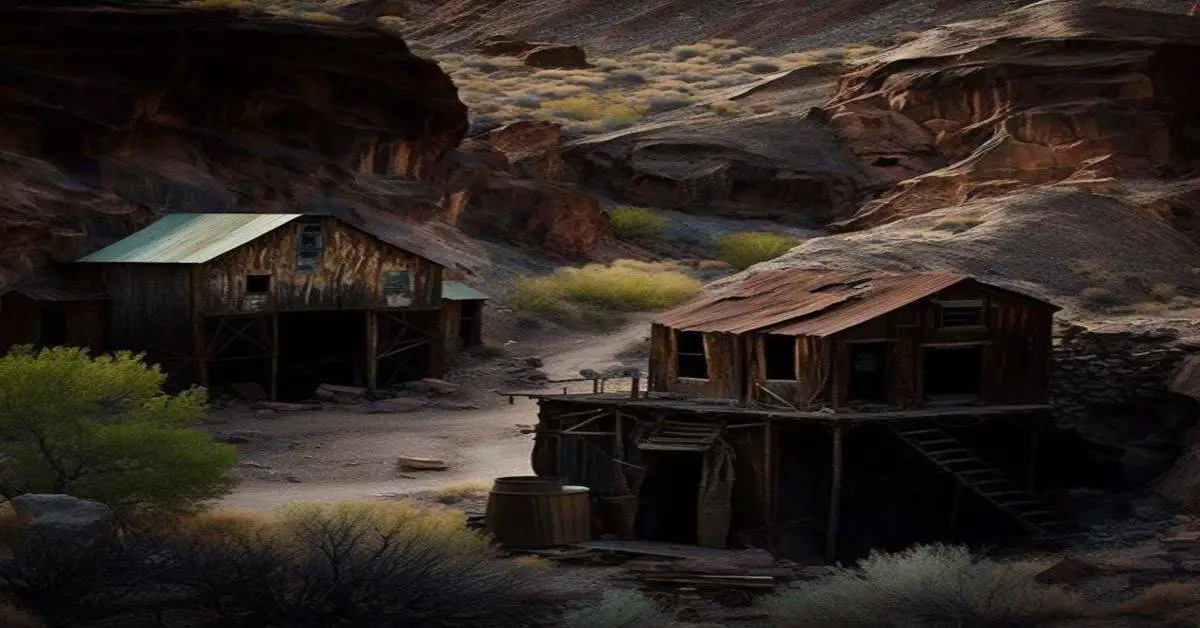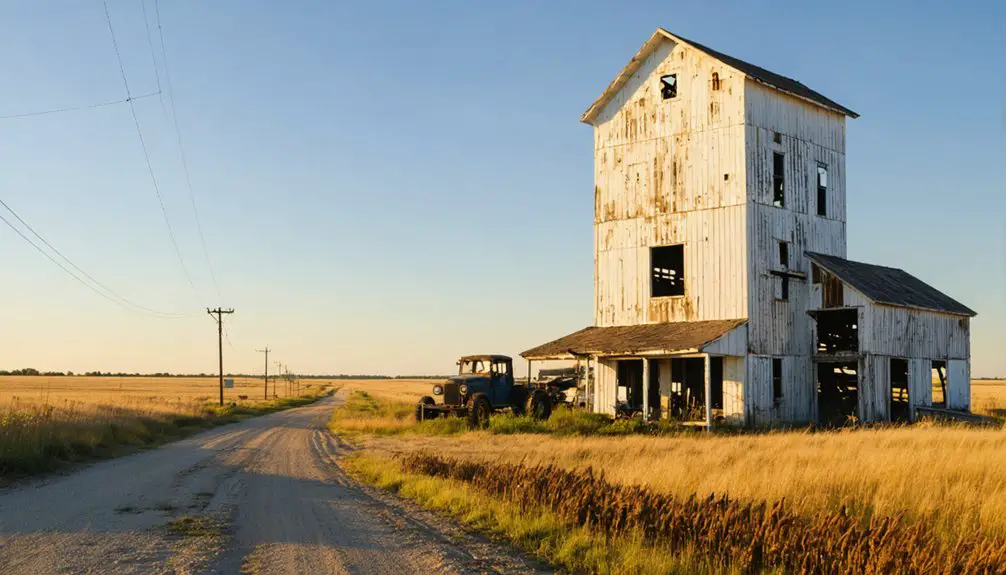You’ll find Omemee in Bottineau County, North Dakota, where two major railroads once created a bustling junction town in the 1890s. At its peak in 1906, this agricultural hub boasted seven grain elevators, multiple businesses, and 650 residents. The town’s fortunes changed with the rise of automobiles and interstate highways, leading to its abandonment by 1990. Today, only two crumbling buildings stand where a thriving community once charted North Dakota’s pioneering spirit.
Key Takeaways
- Omemee thrived as a railroad junction town in North Dakota, reaching 650 residents by 1906 before becoming completely abandoned.
- Two major railroads, Great Northern and Soo Line, established Omemee as a vital transportation hub with seven grain elevators.
- The town’s decline began with the rise of automobiles, Interstate Highway System bypassing, and decreased railroad traffic.
- By 1965, Omemee’s population had dropped to just ten residents, leading to its formal disincorporation around 1990.
- Today, only two deteriorating buildings remain, with the surrounding prairie reclaiming former sites of hotels and grain elevators.
The Rise of a Railroad Boom Town
When the Great Northern Railroad selected Omemee as a depot site in 1893, they set the stage for what would become one of North Dakota’s most promising railroad boom towns.
You can trace the town’s meteoric rise to 1905, when the Soo Line Railroad added its tracks, creating a major junction that positioned Omemee at the crossroads of two of the state’s most significant rail lines. The rapid construction of the Soo Line track was remarkable, with crews laying an impressive 4.2 miles per day.
The railroad impact transformed this prairie outpost into a bustling hub of commerce, drawing Scottish and Canadian immigrant settlement that helped the population soar to 650 by 1906. To avoid confusion with other locations, the town became known as North Dakota Omemee.
Immigrants from Scotland and Canada flocked to Omemee’s booming rail hub, transforming a quiet prairie town into a commercial center.
As Omemee grew into Bottineau County’s fourth-largest town, you’d have found a thriving community complete with Presbyterian and Methodist churches, a brick factory, and a new school – all evidence of the boundless opportunity that railroad connections promised for the American frontier.
Economic Glory Days
During Omemee’s golden age in the early 1900s, you’d find a bustling business district anchored by the railroad depot that connected local commerce to distant markets.
The town’s economic might centered on its impressive seven grain elevators, which served the surrounding farming community and marked Omemee as an essential agricultural hub. The First National Bank, led by prominent citizen Adam Batie, helped finance the town’s growth and development.
You could walk down Main Street and see the prosperity reflected in the town’s two banks, implement dealership, hotel, restaurant, and even a soda factory – proof of the railroad boom that transformed this prairie settlement into a significant commercial center. The local brick and livery businesses added to the diverse commercial landscape that made Omemee thrive.
Railroad Hub Prosperity
As two major railroads converged in Omemee in 1905, the small North Dakota town transformed into a bustling transportation hub that promised metropolitan potential.
You’d have witnessed remarkable railroad innovation as the Great Northern and Soo Line created a strategic junction, connecting 122 grain elevators and enabling swift transport of agricultural goods.
The town’s community resilience shone through its Scottish immigrant population, who built their dreams around this rail nexus.
You could’ve seen the prosperity reflected in the brick factory‘s output, new churches rising from the prairie soil, and the expanding schools serving railway families.
The Soo Line Railroad became instrumental in developing the region’s commerce and infrastructure.
The city’s incorporation in 1902 marked its ambition to rival Bismarck and Fargo, while merchants and farmers thrived on unprecedented market access that the dual rail lines provided.
Thriving Business District
In the early 1900s, you’d have found a vibrant commercial hub in Omemee’s business district, where brick storefronts lined the streets and entrepreneurial spirit thrived. Local businesses catered to every need – from general stores stocking daily essentials to a hotel welcoming travelers.
Two banks managed the town’s finances while an implement dealership supplied farmers with crucial equipment.
The community culture flourished beyond mere commerce. You could catch a show at the opera house, enjoy a meal at the local restaurant, or cheer for one of North Dakota’s finest baseball teams.
When Chris Rasmussen opened his bottling works in 1926, his five-cent orange soda became legendary, made with pure local well water.
With a peak population of 650, Omemee’s business district rivaled larger towns, embodying the freedom and possibility of the American frontier.
Seven Grain Elevators
Towering sentinels of prairie prosperity, Omemee’s seven grain elevators stood as proof of the town’s agricultural might in the early 1900s.
The elevator architecture dominated the skyline, with each structure capable of storing 25,000-30,000 bushels of wheat. These facilities were typical of the era, as small grain elevators were common throughout North Dakota, with around 2,000 such structures operating statewide. You’d have seen a bustling hub of activity as farmers brought their grain for storage and grading, while railroad cars whisked the precious commodity to distant markets.
These grain storage facilities helped Omemee flourish, supporting a population of 650 by 1906. The town’s success attracted numerous businesses, including the Omemee Herald newspaper, which documented the community’s growth.
The elevators weren’t just buildings – they were the economic engines that powered local commerce, created jobs, and connected you to the wider world through rail networks. They represented the independent spirit of prairie farmers and their determination to build a thriving agricultural community.
Life in Early Omemee
While pioneer life demanded remarkable resilience, the early Scottish and Canadian settlers of Omemee carved out a vibrant community from the North Dakota prairie starting in 1887.
You’d have found these pioneers building log houses with their own hands, roofing them with basswood boughs and pine shingles. Their pioneer lifestyle centered on self-sufficiency – hunting for fresh meat during migration and baking bread on stone hearths. Like skilled hunter Hermisdos Carbonneau, many settlers helped their neighbors survive harsh winters by sharing game meat.
Community gatherings revolved around the Presbyterian and Methodist churches, where large families like the English clan with their 42 children would congregate.
You’d have witnessed May 24th celebrations featuring volunteer training, and enjoyed the town’s humor through rhyming business advertisements.
The intersection of the Great Northern and Soo Line railroads brought promise, while local enterprises like the brick factory supported the town’s growth.
The Path to Abandonment

You’ll find Omemee’s decline deeply intertwined with America’s shifting transportation landscape, as the rise of automobiles and interstate highways drew traffic away from this once-bustling railroad hub.
Where seven grain elevators and two banks once served a thriving population of 605 residents in 1906, you’d see these numbers dwindle to just ten people by 1965 as the town’s rail-dependent economy crumbled.
The post-war exodus hit particularly hard when young residents left for military service or West Coast opportunities, leaving Omemee’s businesses and institutions to shutter one by one until its formal disincorporation around 1990.
The town’s vibrant past included an opera house and newspaper, showing just how dramatically this North Dakota community changed over the decades.
Economic Forces Behind Decline
Although Omemee thrived as a bustling agricultural hub in the early 1900s, serving farmers and railroad workers with its diverse businesses, the town’s economic foundation began crumbling during the harsh years of the Great Depression and Dust Bowl.
You’ll find the economic challenges compounded as agricultural mechanization reduced farm labor needs, triggering a mass exodus of workers to urban centers.
While Omemee once boasted banks, grain elevators, a hotel, and even a soda factory, these establishments couldn’t survive the dwindling customer base.
The town’s population trends tell a stark story – from 650 residents in 1906 to just 5 by 1970.
Competition from larger towns like Bottineau and Minot, coupled with declining railroad traffic, delivered the final blow.
As businesses shuttered and young residents left for military service or better opportunities, Omemee’s economic significance faded into memory.
Transportation Changes Accelerate Exodus
The final knockout came with the Interstate Highway System, which bypassed Omemee entirely.
This dramatic population shift emptied the town – from 605 residents in 1906 to just 10 by 1965.
The Soo Line Railroad once made the town a vital transportation junction.
Where you once would’ve found a bustling hub with banks, grain elevators, and a hotel, you’ll now discover only silent reminders of a town that lived and died by its transportation connections.
What Remains Today
Standing as silent witnesses to Omemee’s past, only two crumbling buildings remain at this once-bustling North Dakota railroad town. The derelict remaining structures tell a story of abandonment, with nature slowly reclaiming what humans left behind.
You’ll find an abandoned electric line near the site, while the surrounding prairie stretches undisturbed where hotels and grain elevators once stood.
The most significant cultural artifacts from Omemee’s glory days include:
- The preserved town bell, now displayed away from its original location
- Historic photographs documenting the town’s decline
- Local memories and stories passed down through generations
Since 2003, this true ghost town has stood frozen in time, its empty buildings weathering beneath vast Dakota skies.
No museums chronicle its history – just crumbling walls and prairie winds that whisper tales of freedom lost to time.
Historical Significance and Legacy

Once serving as a vital railroad junction where the Great Northern and Soo Line railroads intersected, Omemee’s legacy transcends its current ghost town status.
As a bustling hub of early 20th century commerce, you’ll find its story woven into North Dakota’s cultural heritage through the memories of grain elevators, brick factories, and one of the state’s finest baseball teams.
The town’s community resilience shines through tales of close-knit neighbors, lively dances, and shared traditions that defined rural life.
While agricultural mechanization and changing transportation patterns ultimately led to its abandonment, Omemee’s impact on regional development remains significant.
Through oral histories and family connections, descendants keep alive the spirit of this once-thriving railroad town that helped shape North Dakota’s agricultural and transportation landscape.
Frequently Asked Questions
Are There Any Remaining Structures Still Standing in Omemee Today?
You’ll find just two remaining buildings still standing, both deteriorating with minimal preservation efforts. They’re lonely sentinels of a forgotten era, accompanied only by an abandoned electric line cutting through town.
What Happened to the Original Residents After Leaving Omemee?
By 1960, over 80% of Omemee residents had relocated, with many finding jobs in Bottineau and Minot. You’ll find they spread across North Dakota and the West Coast, trading farm life for urban opportunities.
Were There Any Notable Crimes or Tragedies in Omemee’s History?
You won’t find unsolved mysteries or violent historical incidents here. The real tragedies were economic decline, wartime population loss, and the slow social death that turned a thriving community into memories.
Can Visitors Legally Explore the Omemee Ghost Town Site?
While you’re enthusiastic to explore, you can’t legally visit without explicit landowner permission. The ghost town regulations are strict since it’s all private property – no public access is currently allowed.
Did Any Famous People Besides Matt Johnson Come From Omemee?
You won’t find other famous folks in Omemee’s history besides Matt Johnson. While local legends celebrate the town’s community spirit, records don’t show any other widely recognized personalities from this place.
References
- https://cool987fm.com/are-there-ghost-towns-near-bisman-lets-hear-your-stories/
- https://ghostsofnorthdakota892857007.wordpress.com/category/omemee-nd/
- https://www.ndstudies.gov/gr8/content/unit-iv-modern-north-dakota-1921-present/lesson-1-changing-landscapes/topic-3-ghost-towns-and-railroads/section-2-omemee
- https://kids.kiddle.co/Omemee
- https://en.wikipedia.org/wiki/Omemee
- https://news.prairiepublic.org/show/dakota-datebook-archive/2022-05-29/soo-line
- https://www.houseofhighways.com/usa/midwest/north-dakota/omemee
- https://www.ndstudies.gov/sites/default/files/LessonPlans/LessonPlan-HighSchool-GhostTownsOfNorthDakota.pdf
- https://commons.und.edu/cgi/viewcontent.cgi?filename=11&article=1000&context=oers&type=additional
- https://ghostsofnorthdakota892857007.wordpress.com/2014/01/16/omemee-and-the-batie-family/



